Diet and Obesity: Factors, Implications, and Management in England
VerifiedAdded on 2021/04/16
|58
|12988
|50
Report
AI Summary
This report investigates the significant public health issue of diet and obesity among adults aged 40-60 in England. The study explores lifestyle habits, psychological perspectives, and the influence of diet on obesogenic conditions. It examines the factors contributing to obesity, including unhealthy diets, physical inactivity, and psychosocial influences, as well as the health implications such as cardiovascular diseases and type 2 diabetes. The research employs a mixed-methods approach, including both quantitative and qualitative data analysis, with thematic analysis focusing on the effects of binge eating and the obesogenic environment. The report also identifies gaps in existing literature, discusses research methodologies, and offers recommendations for obesity management, considering limitations and future research directions. The study highlights the need for a comprehensive health management plan to address the high rates of obesity within the adult population of England.
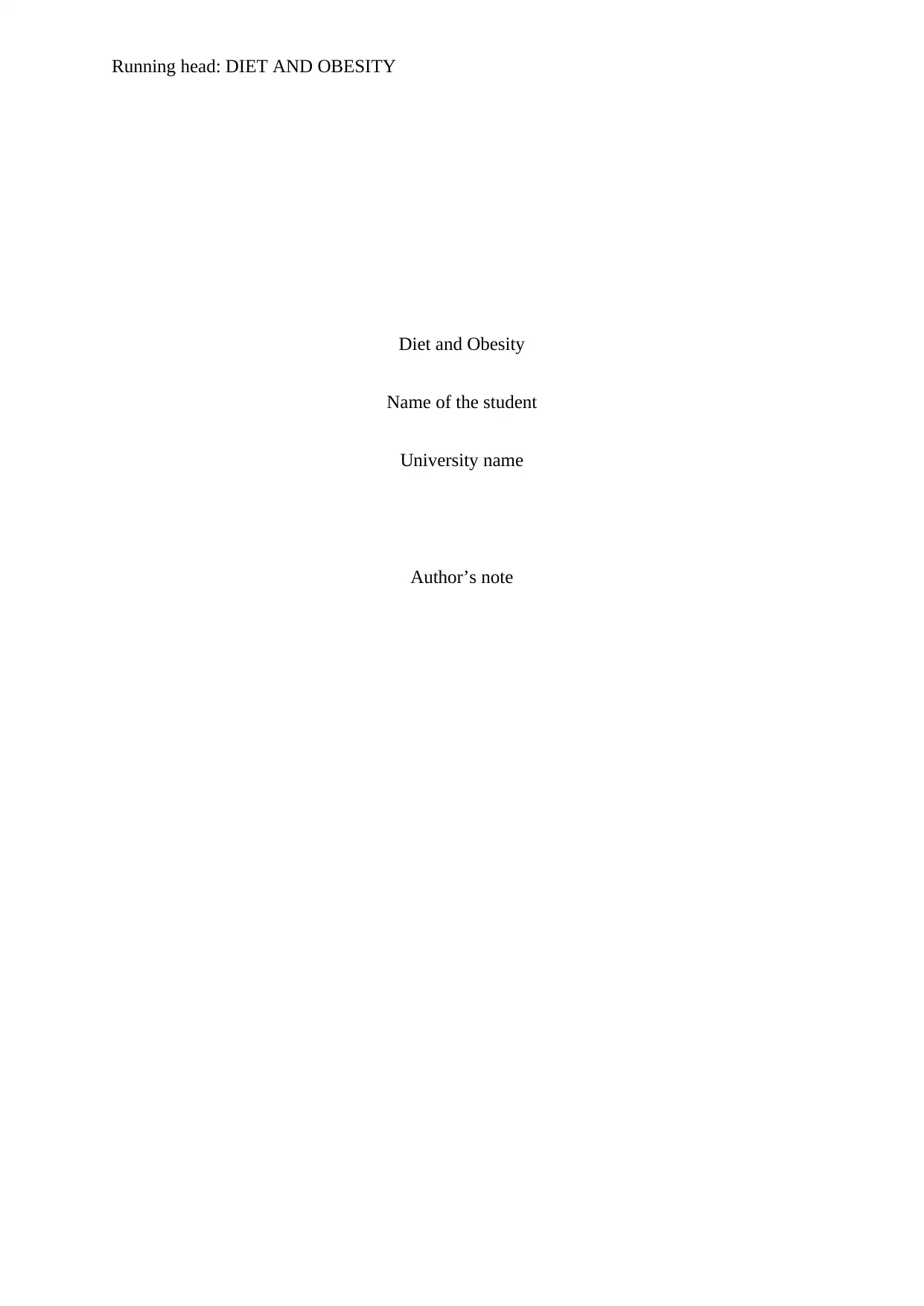
Running head: DIET AND OBESITY
Diet and Obesity
Name of the student
University name
Author’s note
Diet and Obesity
Name of the student
University name
Author’s note
Paraphrase This Document
Need a fresh take? Get an instant paraphrase of this document with our AI Paraphraser
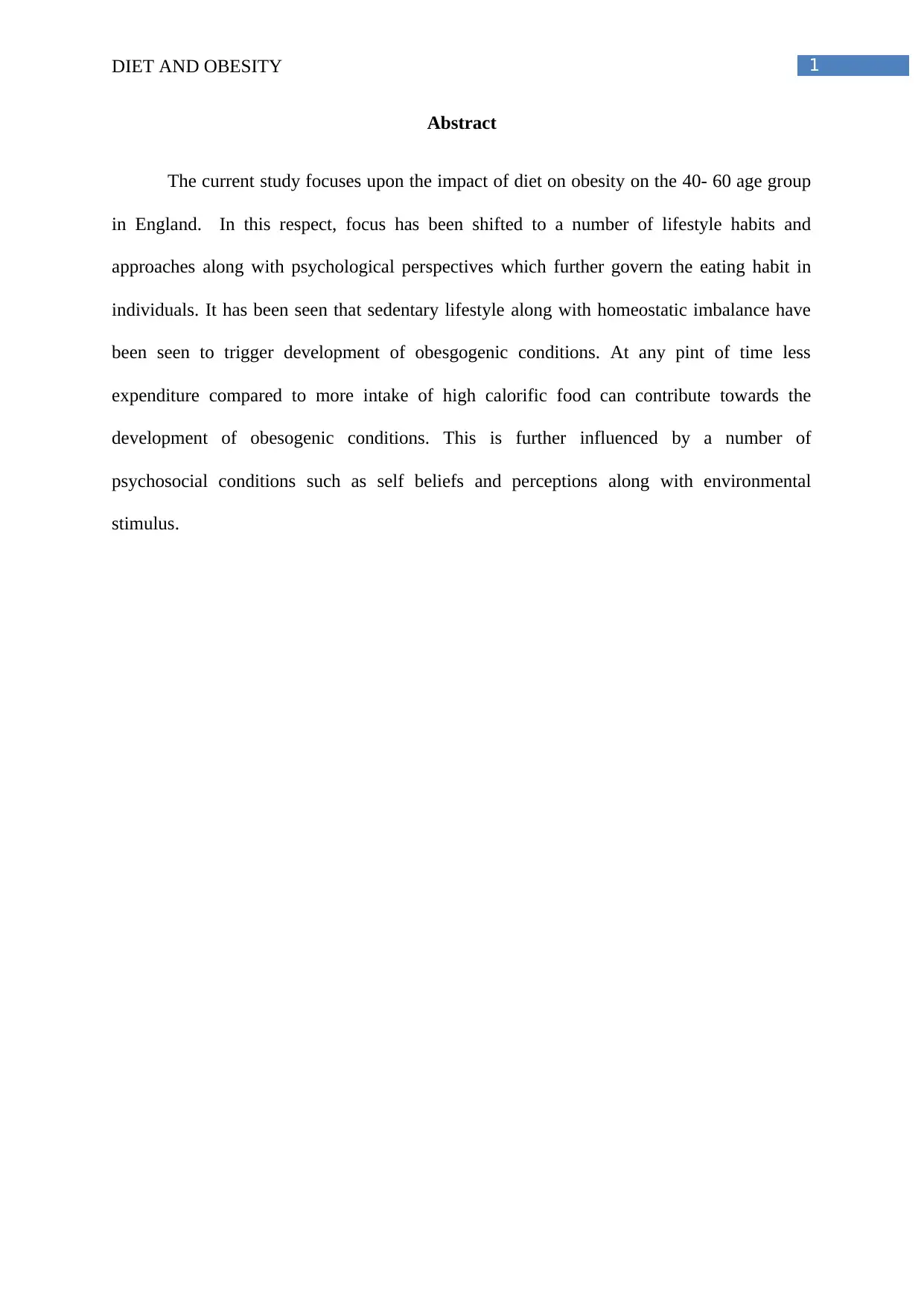
1DIET AND OBESITY
Abstract
The current study focuses upon the impact of diet on obesity on the 40- 60 age group
in England. In this respect, focus has been shifted to a number of lifestyle habits and
approaches along with psychological perspectives which further govern the eating habit in
individuals. It has been seen that sedentary lifestyle along with homeostatic imbalance have
been seen to trigger development of obesgogenic conditions. At any pint of time less
expenditure compared to more intake of high calorific food can contribute towards the
development of obesogenic conditions. This is further influenced by a number of
psychosocial conditions such as self beliefs and perceptions along with environmental
stimulus.
Abstract
The current study focuses upon the impact of diet on obesity on the 40- 60 age group
in England. In this respect, focus has been shifted to a number of lifestyle habits and
approaches along with psychological perspectives which further govern the eating habit in
individuals. It has been seen that sedentary lifestyle along with homeostatic imbalance have
been seen to trigger development of obesgogenic conditions. At any pint of time less
expenditure compared to more intake of high calorific food can contribute towards the
development of obesogenic conditions. This is further influenced by a number of
psychosocial conditions such as self beliefs and perceptions along with environmental
stimulus.
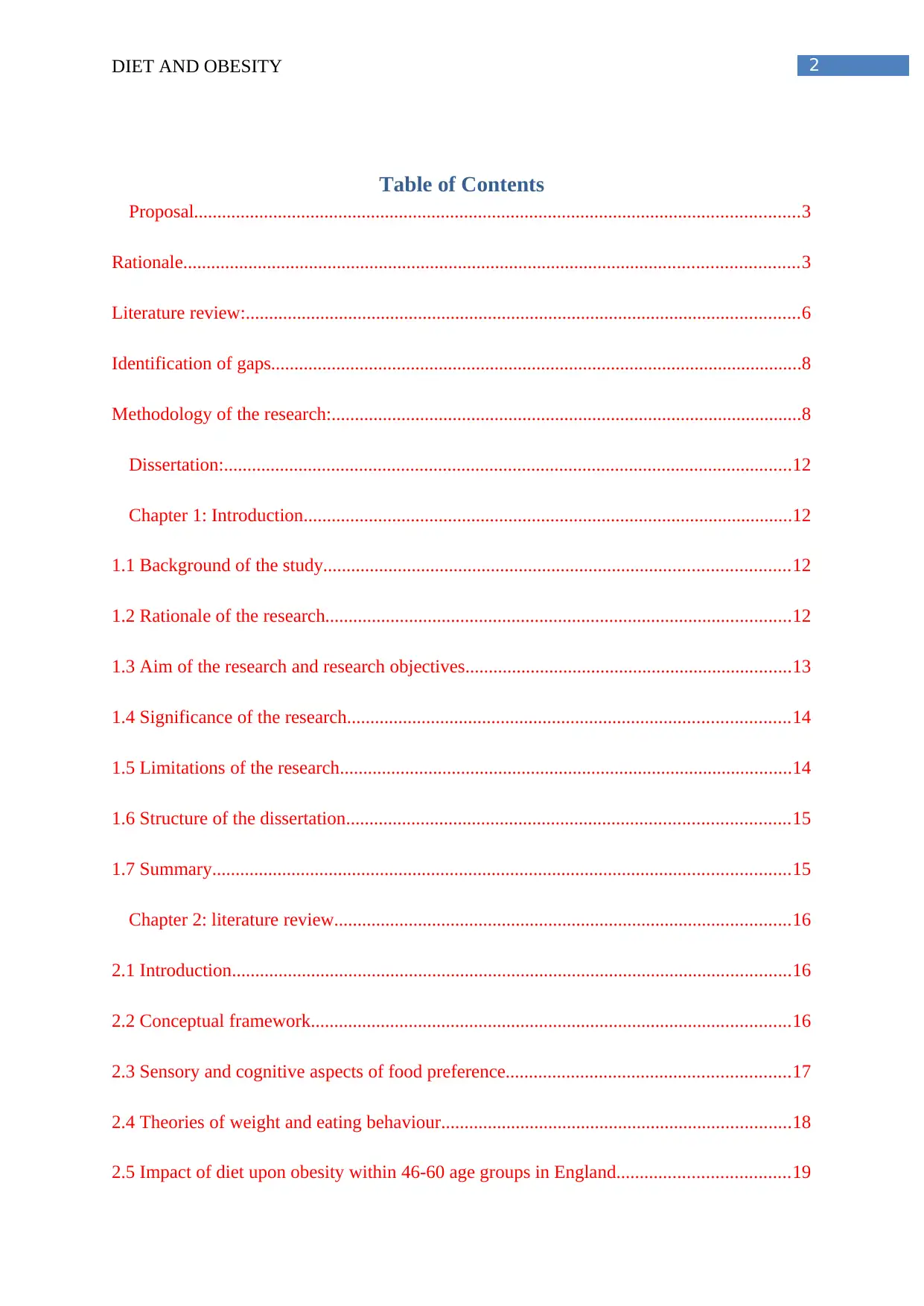
2DIET AND OBESITY
Table of Contents
Proposal..................................................................................................................................3
Rationale....................................................................................................................................3
Literature review:.......................................................................................................................6
Identification of gaps..................................................................................................................8
Methodology of the research:.....................................................................................................8
Dissertation:..........................................................................................................................12
Chapter 1: Introduction.........................................................................................................12
1.1 Background of the study....................................................................................................12
1.2 Rationale of the research....................................................................................................12
1.3 Aim of the research and research objectives......................................................................13
1.4 Significance of the research...............................................................................................14
1.5 Limitations of the research.................................................................................................14
1.6 Structure of the dissertation...............................................................................................15
1.7 Summary............................................................................................................................15
Chapter 2: literature review..................................................................................................16
2.1 Introduction........................................................................................................................16
2.2 Conceptual framework.......................................................................................................16
2.3 Sensory and cognitive aspects of food preference.............................................................17
2.4 Theories of weight and eating behaviour...........................................................................18
2.5 Impact of diet upon obesity within 46-60 age groups in England.....................................19
Table of Contents
Proposal..................................................................................................................................3
Rationale....................................................................................................................................3
Literature review:.......................................................................................................................6
Identification of gaps..................................................................................................................8
Methodology of the research:.....................................................................................................8
Dissertation:..........................................................................................................................12
Chapter 1: Introduction.........................................................................................................12
1.1 Background of the study....................................................................................................12
1.2 Rationale of the research....................................................................................................12
1.3 Aim of the research and research objectives......................................................................13
1.4 Significance of the research...............................................................................................14
1.5 Limitations of the research.................................................................................................14
1.6 Structure of the dissertation...............................................................................................15
1.7 Summary............................................................................................................................15
Chapter 2: literature review..................................................................................................16
2.1 Introduction........................................................................................................................16
2.2 Conceptual framework.......................................................................................................16
2.3 Sensory and cognitive aspects of food preference.............................................................17
2.4 Theories of weight and eating behaviour...........................................................................18
2.5 Impact of diet upon obesity within 46-60 age groups in England.....................................19
⊘ This is a preview!⊘
Do you want full access?
Subscribe today to unlock all pages.

Trusted by 1+ million students worldwide
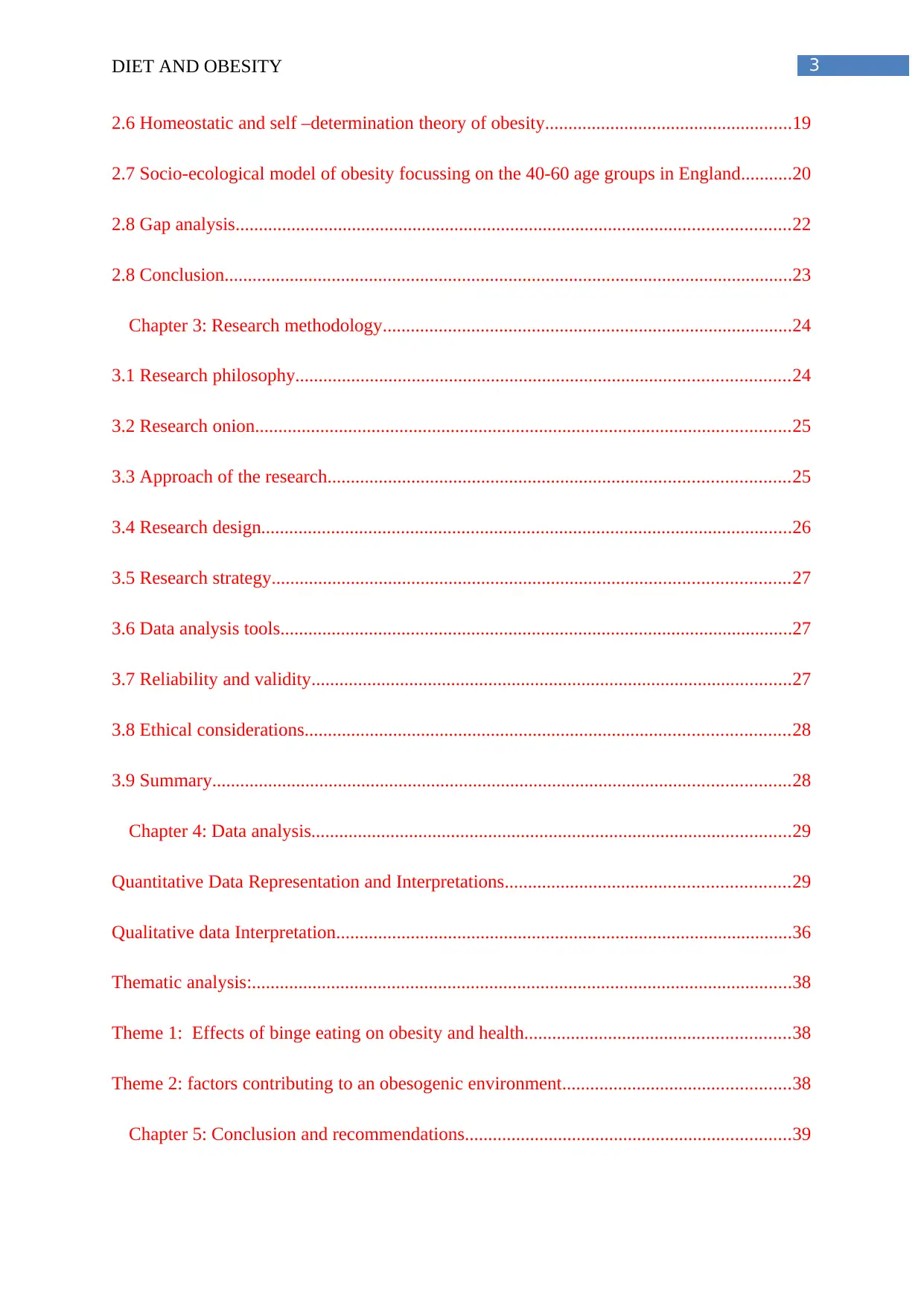
3DIET AND OBESITY
2.6 Homeostatic and self –determination theory of obesity.....................................................19
2.7 Socio-ecological model of obesity focussing on the 40-60 age groups in England...........20
2.8 Gap analysis.......................................................................................................................22
2.8 Conclusion..........................................................................................................................23
Chapter 3: Research methodology........................................................................................24
3.1 Research philosophy..........................................................................................................24
3.2 Research onion...................................................................................................................25
3.3 Approach of the research...................................................................................................25
3.4 Research design..................................................................................................................26
3.5 Research strategy...............................................................................................................27
3.6 Data analysis tools..............................................................................................................27
3.7 Reliability and validity.......................................................................................................27
3.8 Ethical considerations........................................................................................................28
3.9 Summary............................................................................................................................28
Chapter 4: Data analysis.......................................................................................................29
Quantitative Data Representation and Interpretations.............................................................29
Qualitative data Interpretation..................................................................................................36
Thematic analysis:....................................................................................................................38
Theme 1: Effects of binge eating on obesity and health.........................................................38
Theme 2: factors contributing to an obesogenic environment.................................................38
Chapter 5: Conclusion and recommendations......................................................................39
2.6 Homeostatic and self –determination theory of obesity.....................................................19
2.7 Socio-ecological model of obesity focussing on the 40-60 age groups in England...........20
2.8 Gap analysis.......................................................................................................................22
2.8 Conclusion..........................................................................................................................23
Chapter 3: Research methodology........................................................................................24
3.1 Research philosophy..........................................................................................................24
3.2 Research onion...................................................................................................................25
3.3 Approach of the research...................................................................................................25
3.4 Research design..................................................................................................................26
3.5 Research strategy...............................................................................................................27
3.6 Data analysis tools..............................................................................................................27
3.7 Reliability and validity.......................................................................................................27
3.8 Ethical considerations........................................................................................................28
3.9 Summary............................................................................................................................28
Chapter 4: Data analysis.......................................................................................................29
Quantitative Data Representation and Interpretations.............................................................29
Qualitative data Interpretation..................................................................................................36
Thematic analysis:....................................................................................................................38
Theme 1: Effects of binge eating on obesity and health.........................................................38
Theme 2: factors contributing to an obesogenic environment.................................................38
Chapter 5: Conclusion and recommendations......................................................................39
Paraphrase This Document
Need a fresh take? Get an instant paraphrase of this document with our AI Paraphraser

4DIET AND OBESITY
5.1 Conclusion..........................................................................................................................39
5.2 Linking with objectives......................................................................................................40
5.3 Recommendations:.............................................................................................................42
5.4 Research limitations...........................................................................................................43
5.5 Future scope of the study...................................................................................................44
References................................................................................................................................47
5.1 Conclusion..........................................................................................................................39
5.2 Linking with objectives......................................................................................................40
5.3 Recommendations:.............................................................................................................42
5.4 Research limitations...........................................................................................................43
5.5 Future scope of the study...................................................................................................44
References................................................................................................................................47
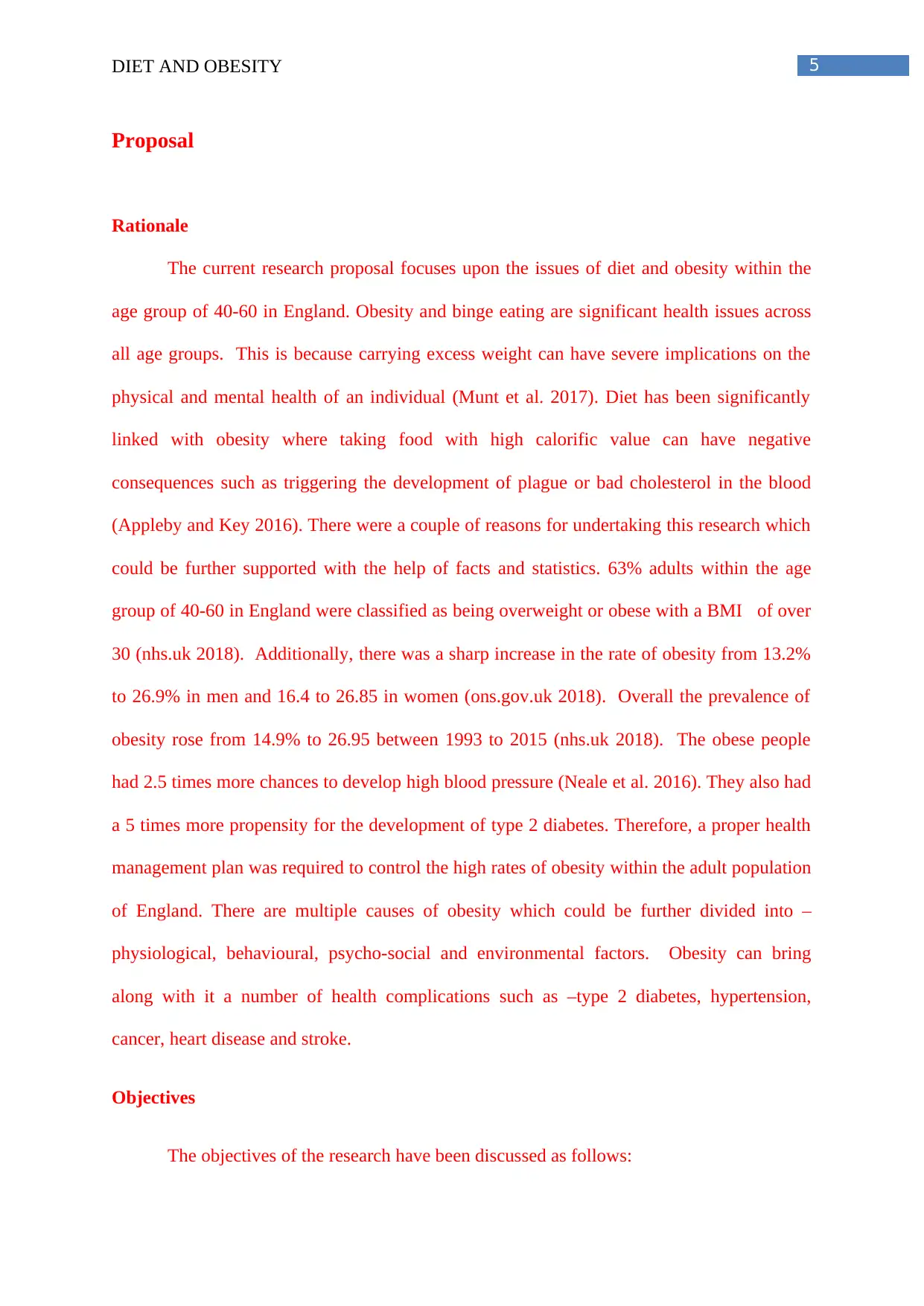
5DIET AND OBESITY
Proposal
Rationale
The current research proposal focuses upon the issues of diet and obesity within the
age group of 40-60 in England. Obesity and binge eating are significant health issues across
all age groups. This is because carrying excess weight can have severe implications on the
physical and mental health of an individual (Munt et al. 2017). Diet has been significantly
linked with obesity where taking food with high calorific value can have negative
consequences such as triggering the development of plague or bad cholesterol in the blood
(Appleby and Key 2016). There were a couple of reasons for undertaking this research which
could be further supported with the help of facts and statistics. 63% adults within the age
group of 40-60 in England were classified as being overweight or obese with a BMI of over
30 (nhs.uk 2018). Additionally, there was a sharp increase in the rate of obesity from 13.2%
to 26.9% in men and 16.4 to 26.85 in women (ons.gov.uk 2018). Overall the prevalence of
obesity rose from 14.9% to 26.95 between 1993 to 2015 (nhs.uk 2018). The obese people
had 2.5 times more chances to develop high blood pressure (Neale et al. 2016). They also had
a 5 times more propensity for the development of type 2 diabetes. Therefore, a proper health
management plan was required to control the high rates of obesity within the adult population
of England. There are multiple causes of obesity which could be further divided into –
physiological, behavioural, psycho-social and environmental factors. Obesity can bring
along with it a number of health complications such as –type 2 diabetes, hypertension,
cancer, heart disease and stroke.
Objectives
The objectives of the research have been discussed as follows:
Proposal
Rationale
The current research proposal focuses upon the issues of diet and obesity within the
age group of 40-60 in England. Obesity and binge eating are significant health issues across
all age groups. This is because carrying excess weight can have severe implications on the
physical and mental health of an individual (Munt et al. 2017). Diet has been significantly
linked with obesity where taking food with high calorific value can have negative
consequences such as triggering the development of plague or bad cholesterol in the blood
(Appleby and Key 2016). There were a couple of reasons for undertaking this research which
could be further supported with the help of facts and statistics. 63% adults within the age
group of 40-60 in England were classified as being overweight or obese with a BMI of over
30 (nhs.uk 2018). Additionally, there was a sharp increase in the rate of obesity from 13.2%
to 26.9% in men and 16.4 to 26.85 in women (ons.gov.uk 2018). Overall the prevalence of
obesity rose from 14.9% to 26.95 between 1993 to 2015 (nhs.uk 2018). The obese people
had 2.5 times more chances to develop high blood pressure (Neale et al. 2016). They also had
a 5 times more propensity for the development of type 2 diabetes. Therefore, a proper health
management plan was required to control the high rates of obesity within the adult population
of England. There are multiple causes of obesity which could be further divided into –
physiological, behavioural, psycho-social and environmental factors. Obesity can bring
along with it a number of health complications such as –type 2 diabetes, hypertension,
cancer, heart disease and stroke.
Objectives
The objectives of the research have been discussed as follows:
⊘ This is a preview!⊘
Do you want full access?
Subscribe today to unlock all pages.

Trusted by 1+ million students worldwide
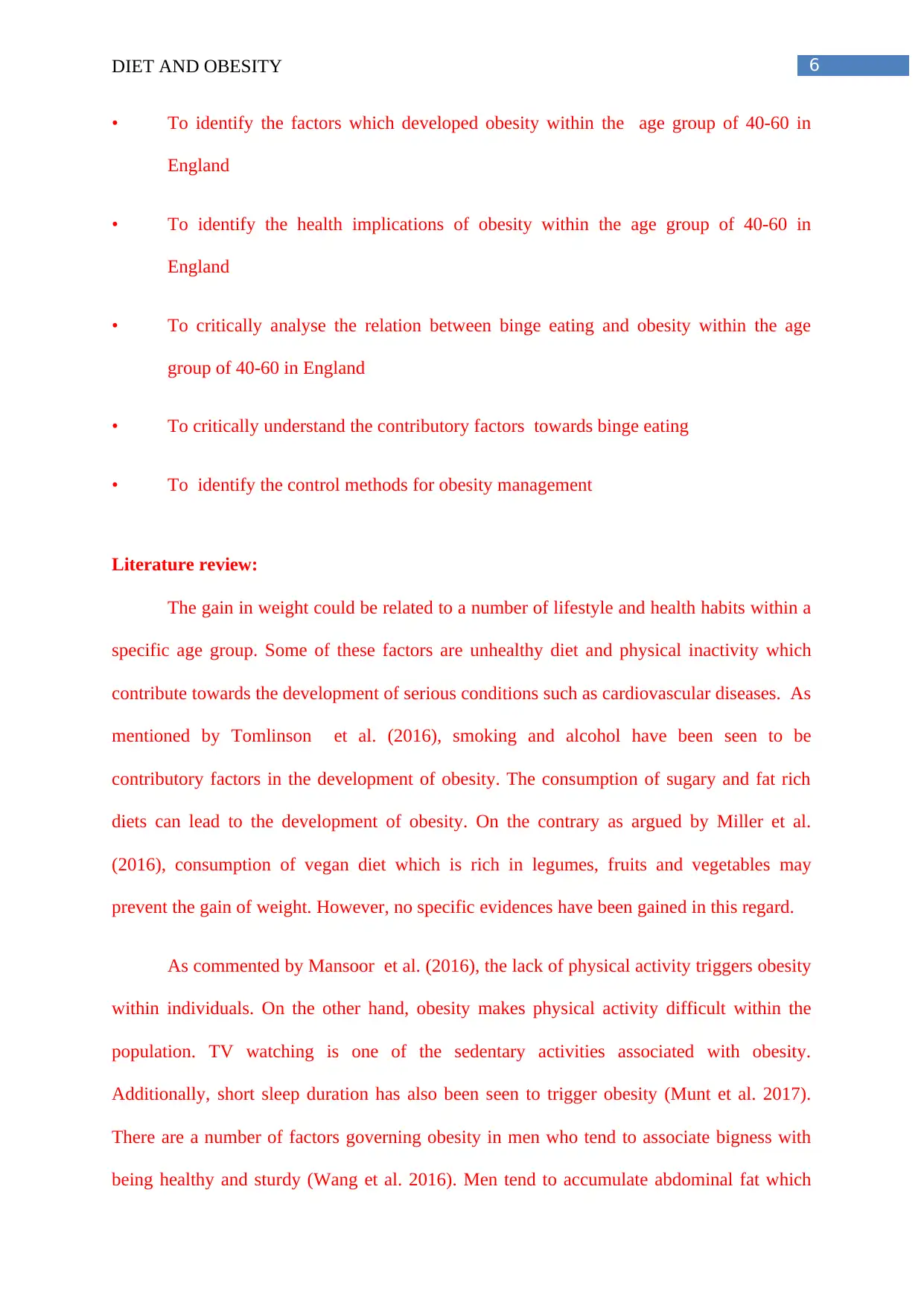
6DIET AND OBESITY
• To identify the factors which developed obesity within the age group of 40-60 in
England
• To identify the health implications of obesity within the age group of 40-60 in
England
• To critically analyse the relation between binge eating and obesity within the age
group of 40-60 in England
• To critically understand the contributory factors towards binge eating
• To identify the control methods for obesity management
Literature review:
The gain in weight could be related to a number of lifestyle and health habits within a
specific age group. Some of these factors are unhealthy diet and physical inactivity which
contribute towards the development of serious conditions such as cardiovascular diseases. As
mentioned by Tomlinson et al. (2016), smoking and alcohol have been seen to be
contributory factors in the development of obesity. The consumption of sugary and fat rich
diets can lead to the development of obesity. On the contrary as argued by Miller et al.
(2016), consumption of vegan diet which is rich in legumes, fruits and vegetables may
prevent the gain of weight. However, no specific evidences have been gained in this regard.
As commented by Mansoor et al. (2016), the lack of physical activity triggers obesity
within individuals. On the other hand, obesity makes physical activity difficult within the
population. TV watching is one of the sedentary activities associated with obesity.
Additionally, short sleep duration has also been seen to trigger obesity (Munt et al. 2017).
There are a number of factors governing obesity in men who tend to associate bigness with
being healthy and sturdy (Wang et al. 2016). Men tend to accumulate abdominal fat which
• To identify the factors which developed obesity within the age group of 40-60 in
England
• To identify the health implications of obesity within the age group of 40-60 in
England
• To critically analyse the relation between binge eating and obesity within the age
group of 40-60 in England
• To critically understand the contributory factors towards binge eating
• To identify the control methods for obesity management
Literature review:
The gain in weight could be related to a number of lifestyle and health habits within a
specific age group. Some of these factors are unhealthy diet and physical inactivity which
contribute towards the development of serious conditions such as cardiovascular diseases. As
mentioned by Tomlinson et al. (2016), smoking and alcohol have been seen to be
contributory factors in the development of obesity. The consumption of sugary and fat rich
diets can lead to the development of obesity. On the contrary as argued by Miller et al.
(2016), consumption of vegan diet which is rich in legumes, fruits and vegetables may
prevent the gain of weight. However, no specific evidences have been gained in this regard.
As commented by Mansoor et al. (2016), the lack of physical activity triggers obesity
within individuals. On the other hand, obesity makes physical activity difficult within the
population. TV watching is one of the sedentary activities associated with obesity.
Additionally, short sleep duration has also been seen to trigger obesity (Munt et al. 2017).
There are a number of factors governing obesity in men who tend to associate bigness with
being healthy and sturdy (Wang et al. 2016). Men tend to accumulate abdominal fat which
Paraphrase This Document
Need a fresh take? Get an instant paraphrase of this document with our AI Paraphraser
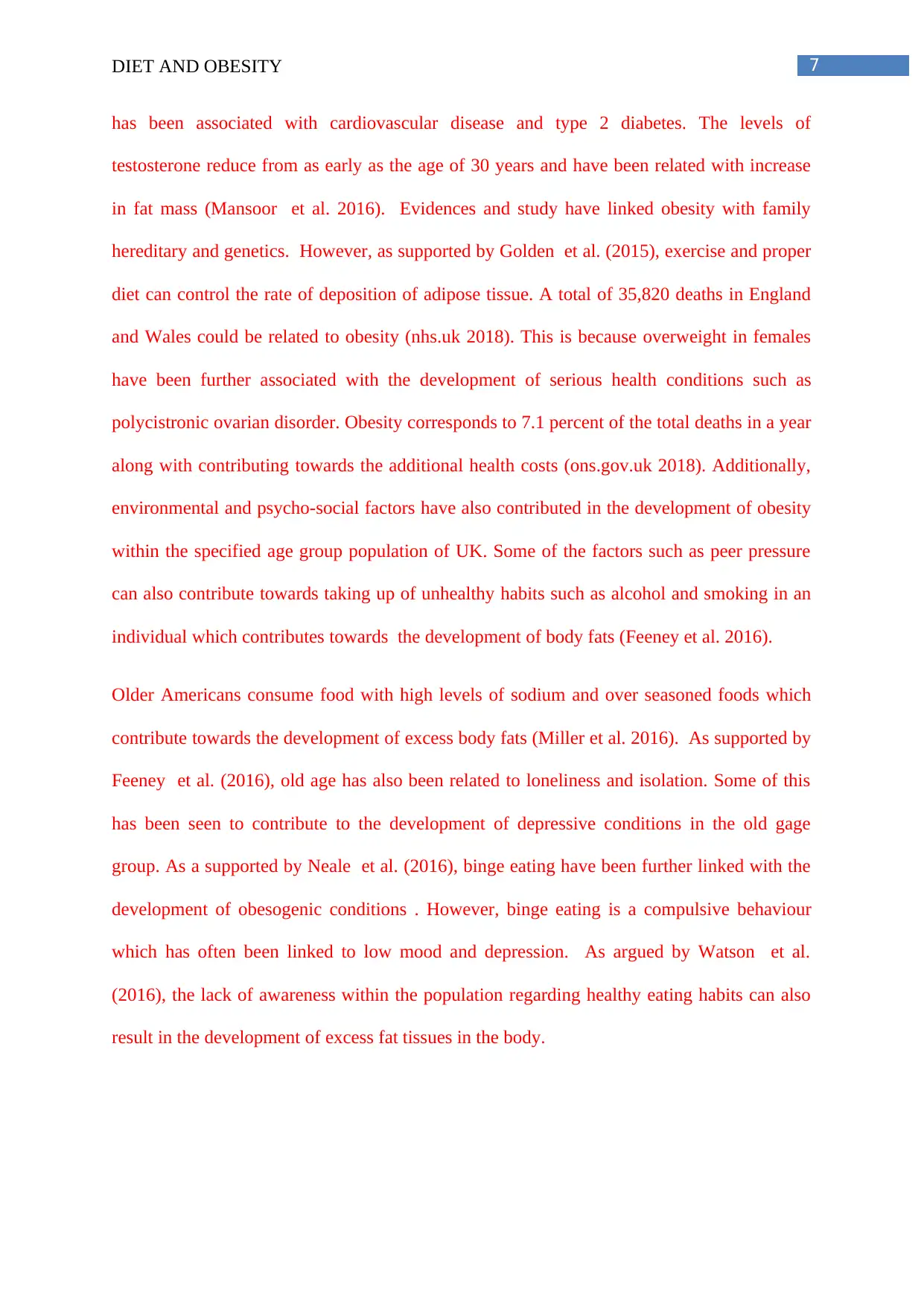
7DIET AND OBESITY
has been associated with cardiovascular disease and type 2 diabetes. The levels of
testosterone reduce from as early as the age of 30 years and have been related with increase
in fat mass (Mansoor et al. 2016). Evidences and study have linked obesity with family
hereditary and genetics. However, as supported by Golden et al. (2015), exercise and proper
diet can control the rate of deposition of adipose tissue. A total of 35,820 deaths in England
and Wales could be related to obesity (nhs.uk 2018). This is because overweight in females
have been further associated with the development of serious health conditions such as
polycistronic ovarian disorder. Obesity corresponds to 7.1 percent of the total deaths in a year
along with contributing towards the additional health costs (ons.gov.uk 2018). Additionally,
environmental and psycho-social factors have also contributed in the development of obesity
within the specified age group population of UK. Some of the factors such as peer pressure
can also contribute towards taking up of unhealthy habits such as alcohol and smoking in an
individual which contributes towards the development of body fats (Feeney et al. 2016).
Older Americans consume food with high levels of sodium and over seasoned foods which
contribute towards the development of excess body fats (Miller et al. 2016). As supported by
Feeney et al. (2016), old age has also been related to loneliness and isolation. Some of this
has been seen to contribute to the development of depressive conditions in the old gage
group. As a supported by Neale et al. (2016), binge eating have been further linked with the
development of obesogenic conditions . However, binge eating is a compulsive behaviour
which has often been linked to low mood and depression. As argued by Watson et al.
(2016), the lack of awareness within the population regarding healthy eating habits can also
result in the development of excess fat tissues in the body.
has been associated with cardiovascular disease and type 2 diabetes. The levels of
testosterone reduce from as early as the age of 30 years and have been related with increase
in fat mass (Mansoor et al. 2016). Evidences and study have linked obesity with family
hereditary and genetics. However, as supported by Golden et al. (2015), exercise and proper
diet can control the rate of deposition of adipose tissue. A total of 35,820 deaths in England
and Wales could be related to obesity (nhs.uk 2018). This is because overweight in females
have been further associated with the development of serious health conditions such as
polycistronic ovarian disorder. Obesity corresponds to 7.1 percent of the total deaths in a year
along with contributing towards the additional health costs (ons.gov.uk 2018). Additionally,
environmental and psycho-social factors have also contributed in the development of obesity
within the specified age group population of UK. Some of the factors such as peer pressure
can also contribute towards taking up of unhealthy habits such as alcohol and smoking in an
individual which contributes towards the development of body fats (Feeney et al. 2016).
Older Americans consume food with high levels of sodium and over seasoned foods which
contribute towards the development of excess body fats (Miller et al. 2016). As supported by
Feeney et al. (2016), old age has also been related to loneliness and isolation. Some of this
has been seen to contribute to the development of depressive conditions in the old gage
group. As a supported by Neale et al. (2016), binge eating have been further linked with the
development of obesogenic conditions . However, binge eating is a compulsive behaviour
which has often been linked to low mood and depression. As argued by Watson et al.
(2016), the lack of awareness within the population regarding healthy eating habits can also
result in the development of excess fat tissues in the body.
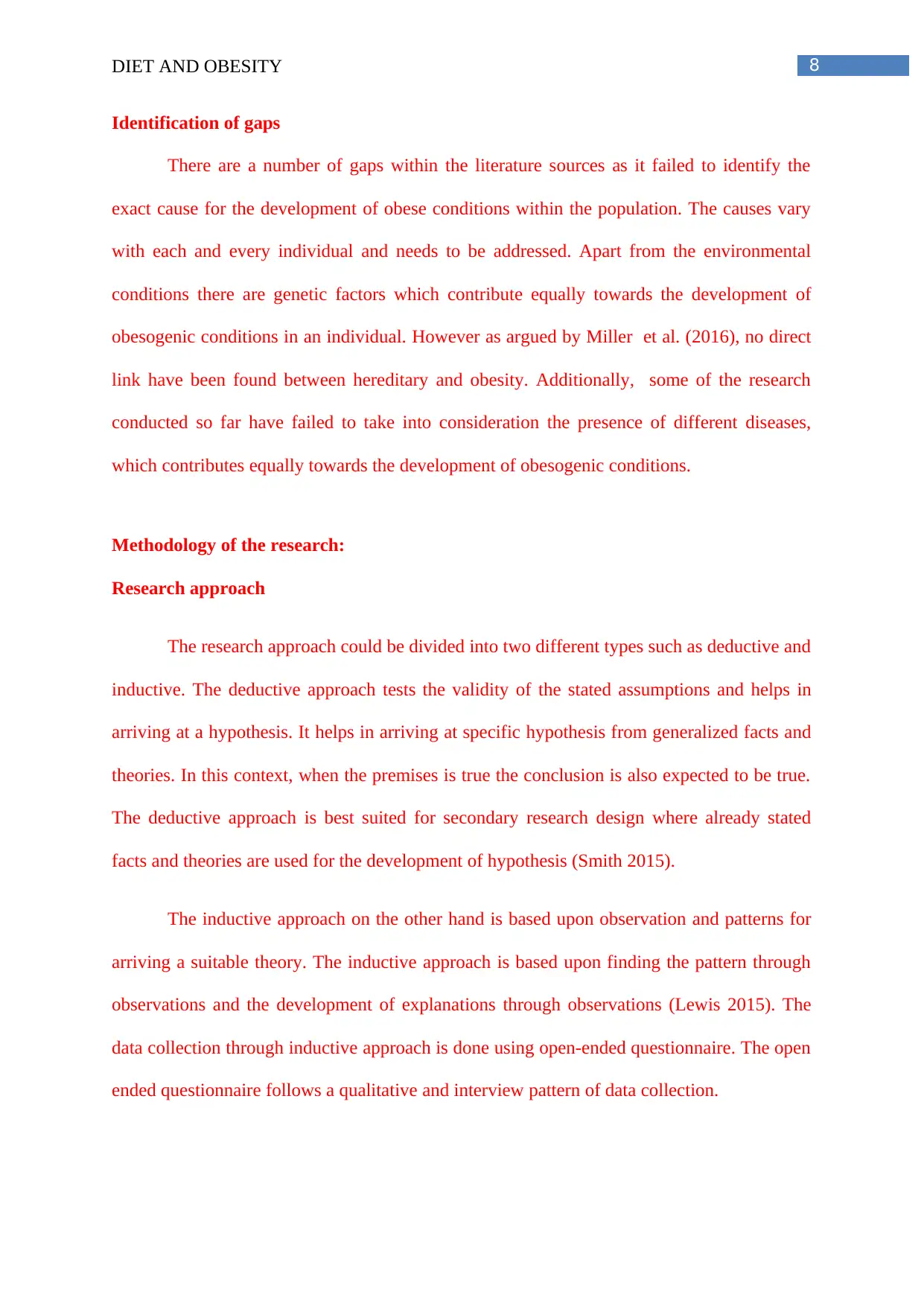
8DIET AND OBESITY
Identification of gaps
There are a number of gaps within the literature sources as it failed to identify the
exact cause for the development of obese conditions within the population. The causes vary
with each and every individual and needs to be addressed. Apart from the environmental
conditions there are genetic factors which contribute equally towards the development of
obesogenic conditions in an individual. However as argued by Miller et al. (2016), no direct
link have been found between hereditary and obesity. Additionally, some of the research
conducted so far have failed to take into consideration the presence of different diseases,
which contributes equally towards the development of obesogenic conditions.
Methodology of the research:
Research approach
The research approach could be divided into two different types such as deductive and
inductive. The deductive approach tests the validity of the stated assumptions and helps in
arriving at a hypothesis. It helps in arriving at specific hypothesis from generalized facts and
theories. In this context, when the premises is true the conclusion is also expected to be true.
The deductive approach is best suited for secondary research design where already stated
facts and theories are used for the development of hypothesis (Smith 2015).
The inductive approach on the other hand is based upon observation and patterns for
arriving a suitable theory. The inductive approach is based upon finding the pattern through
observations and the development of explanations through observations (Lewis 2015). The
data collection through inductive approach is done using open-ended questionnaire. The open
ended questionnaire follows a qualitative and interview pattern of data collection.
Identification of gaps
There are a number of gaps within the literature sources as it failed to identify the
exact cause for the development of obese conditions within the population. The causes vary
with each and every individual and needs to be addressed. Apart from the environmental
conditions there are genetic factors which contribute equally towards the development of
obesogenic conditions in an individual. However as argued by Miller et al. (2016), no direct
link have been found between hereditary and obesity. Additionally, some of the research
conducted so far have failed to take into consideration the presence of different diseases,
which contributes equally towards the development of obesogenic conditions.
Methodology of the research:
Research approach
The research approach could be divided into two different types such as deductive and
inductive. The deductive approach tests the validity of the stated assumptions and helps in
arriving at a hypothesis. It helps in arriving at specific hypothesis from generalized facts and
theories. In this context, when the premises is true the conclusion is also expected to be true.
The deductive approach is best suited for secondary research design where already stated
facts and theories are used for the development of hypothesis (Smith 2015).
The inductive approach on the other hand is based upon observation and patterns for
arriving a suitable theory. The inductive approach is based upon finding the pattern through
observations and the development of explanations through observations (Lewis 2015). The
data collection through inductive approach is done using open-ended questionnaire. The open
ended questionnaire follows a qualitative and interview pattern of data collection.
⊘ This is a preview!⊘
Do you want full access?
Subscribe today to unlock all pages.

Trusted by 1+ million students worldwide
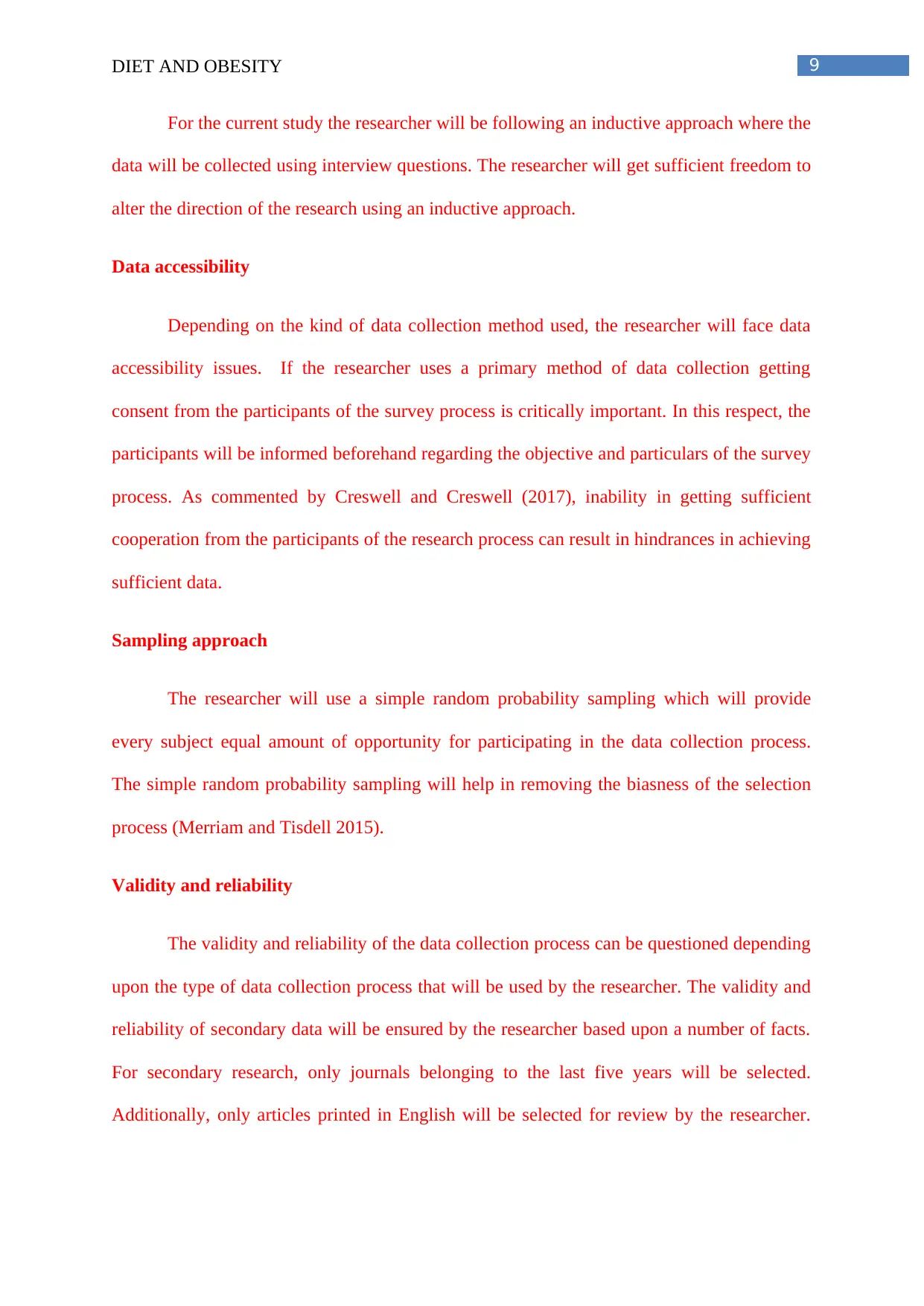
9DIET AND OBESITY
For the current study the researcher will be following an inductive approach where the
data will be collected using interview questions. The researcher will get sufficient freedom to
alter the direction of the research using an inductive approach.
Data accessibility
Depending on the kind of data collection method used, the researcher will face data
accessibility issues. If the researcher uses a primary method of data collection getting
consent from the participants of the survey process is critically important. In this respect, the
participants will be informed beforehand regarding the objective and particulars of the survey
process. As commented by Creswell and Creswell (2017), inability in getting sufficient
cooperation from the participants of the research process can result in hindrances in achieving
sufficient data.
Sampling approach
The researcher will use a simple random probability sampling which will provide
every subject equal amount of opportunity for participating in the data collection process.
The simple random probability sampling will help in removing the biasness of the selection
process (Merriam and Tisdell 2015).
Validity and reliability
The validity and reliability of the data collection process can be questioned depending
upon the type of data collection process that will be used by the researcher. The validity and
reliability of secondary data will be ensured by the researcher based upon a number of facts.
For secondary research, only journals belonging to the last five years will be selected.
Additionally, only articles printed in English will be selected for review by the researcher.
For the current study the researcher will be following an inductive approach where the
data will be collected using interview questions. The researcher will get sufficient freedom to
alter the direction of the research using an inductive approach.
Data accessibility
Depending on the kind of data collection method used, the researcher will face data
accessibility issues. If the researcher uses a primary method of data collection getting
consent from the participants of the survey process is critically important. In this respect, the
participants will be informed beforehand regarding the objective and particulars of the survey
process. As commented by Creswell and Creswell (2017), inability in getting sufficient
cooperation from the participants of the research process can result in hindrances in achieving
sufficient data.
Sampling approach
The researcher will use a simple random probability sampling which will provide
every subject equal amount of opportunity for participating in the data collection process.
The simple random probability sampling will help in removing the biasness of the selection
process (Merriam and Tisdell 2015).
Validity and reliability
The validity and reliability of the data collection process can be questioned depending
upon the type of data collection process that will be used by the researcher. The validity and
reliability of secondary data will be ensured by the researcher based upon a number of facts.
For secondary research, only journals belonging to the last five years will be selected.
Additionally, only articles printed in English will be selected for review by the researcher.
Paraphrase This Document
Need a fresh take? Get an instant paraphrase of this document with our AI Paraphraser
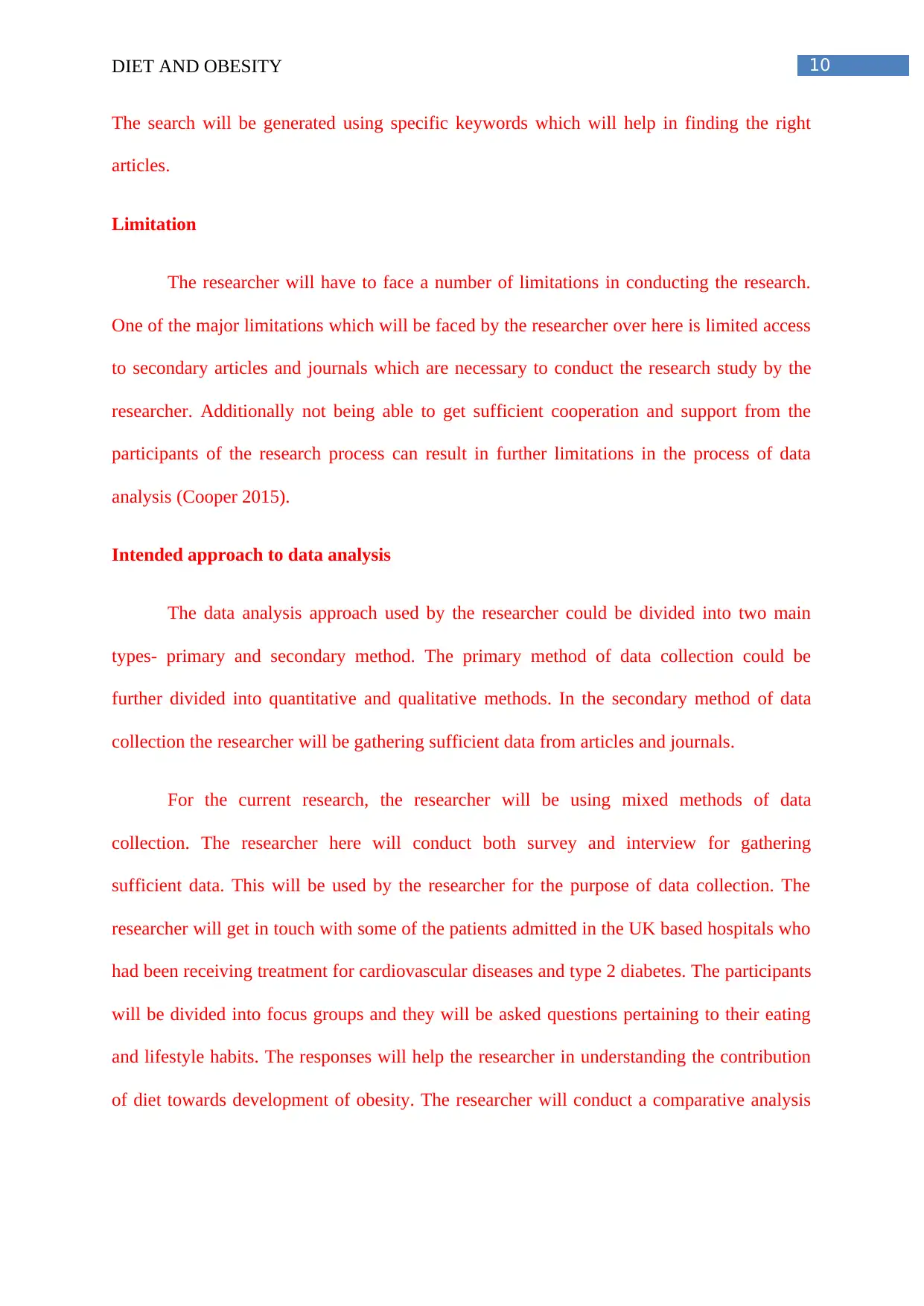
10DIET AND OBESITY
The search will be generated using specific keywords which will help in finding the right
articles.
Limitation
The researcher will have to face a number of limitations in conducting the research.
One of the major limitations which will be faced by the researcher over here is limited access
to secondary articles and journals which are necessary to conduct the research study by the
researcher. Additionally not being able to get sufficient cooperation and support from the
participants of the research process can result in further limitations in the process of data
analysis (Cooper 2015).
Intended approach to data analysis
The data analysis approach used by the researcher could be divided into two main
types- primary and secondary method. The primary method of data collection could be
further divided into quantitative and qualitative methods. In the secondary method of data
collection the researcher will be gathering sufficient data from articles and journals.
For the current research, the researcher will be using mixed methods of data
collection. The researcher here will conduct both survey and interview for gathering
sufficient data. This will be used by the researcher for the purpose of data collection. The
researcher will get in touch with some of the patients admitted in the UK based hospitals who
had been receiving treatment for cardiovascular diseases and type 2 diabetes. The participants
will be divided into focus groups and they will be asked questions pertaining to their eating
and lifestyle habits. The responses will help the researcher in understanding the contribution
of diet towards development of obesity. The researcher will conduct a comparative analysis
The search will be generated using specific keywords which will help in finding the right
articles.
Limitation
The researcher will have to face a number of limitations in conducting the research.
One of the major limitations which will be faced by the researcher over here is limited access
to secondary articles and journals which are necessary to conduct the research study by the
researcher. Additionally not being able to get sufficient cooperation and support from the
participants of the research process can result in further limitations in the process of data
analysis (Cooper 2015).
Intended approach to data analysis
The data analysis approach used by the researcher could be divided into two main
types- primary and secondary method. The primary method of data collection could be
further divided into quantitative and qualitative methods. In the secondary method of data
collection the researcher will be gathering sufficient data from articles and journals.
For the current research, the researcher will be using mixed methods of data
collection. The researcher here will conduct both survey and interview for gathering
sufficient data. This will be used by the researcher for the purpose of data collection. The
researcher will get in touch with some of the patients admitted in the UK based hospitals who
had been receiving treatment for cardiovascular diseases and type 2 diabetes. The participants
will be divided into focus groups and they will be asked questions pertaining to their eating
and lifestyle habits. The responses will help the researcher in understanding the contribution
of diet towards development of obesity. The researcher will conduct a comparative analysis

11DIET AND OBESITY
using qualitative and quantitative methods which will help them in arriving at important
results and data.
using qualitative and quantitative methods which will help them in arriving at important
results and data.
⊘ This is a preview!⊘
Do you want full access?
Subscribe today to unlock all pages.

Trusted by 1+ million students worldwide
1 out of 58
Related Documents
Your All-in-One AI-Powered Toolkit for Academic Success.
+13062052269
info@desklib.com
Available 24*7 on WhatsApp / Email
![[object Object]](/_next/static/media/star-bottom.7253800d.svg)
Unlock your academic potential
Copyright © 2020–2025 A2Z Services. All Rights Reserved. Developed and managed by ZUCOL.





